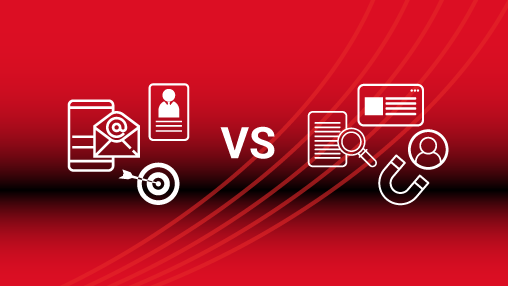What is account-based marketing (ABM)?
Account-based marketing is a strategic approach that focuses marketing and sales efforts on a clearly defined set of target accounts. Unlike other marketing strategies that cast a wide net, ABM narrows in on just the accounts that offer the greatest potential value.
The key components of an effective ABM strategy include:
- Target account selection – Researching and identifying your best-fit accounts that align with your ideal customer profile (ICP). Factors like company size, industry, tech stack, and potential deal size help determine priority accounts
- Persona development – Creating detailed buyer personas for your target accounts so messaging can be hyper-personalized. Personas represent various roles in the buying process
- Tailored messaging – Crafting customized campaigns, emails, ads, and content for each persona within your target accounts. This shows prospects you understand their pain points
The main advantages of ABM include:
- Highly personalized outreach – Communication is focused on each account’s needs rather than generic content
- Increased relevance – Content and messaging resonates more when it’s tailored to a prospect’s specific challenges
- Higher conversion rates – When implemented correctly, ABM delivers significantly higher conversion rates than traditional marketing. In fact, 88% of B2B marketers have reported an improvement in conversion rates when using an ABM strategy
- Enhanced sales and marketing alignment – With shared target accounts, sales and marketing teams can collaborate seamlessly
ABM delivers a personalized experience that breaks through the noise to engage accounts more meaningfully. The tailored approach leads to higher ROI and faster deals.
What is inbound marketing?
Inbound marketing is a strategy focused on attracting customers through content and interactions that are relevant and helpful. Unlike outbound marketing, which interrupts potential customers with techniques such as cold calling or email blasts, inbound marketing earns their attention by creating content tailored specifically to the interests and needs of target personas and various stages of the buyer’s journey.
Riaz Kanani, CEO and founder of Radiate B2B, notes that the popularity of inbound marketing means an increasing level of personalization is required to cut through and be heard in a crowded market. In fact, 69% of B2B buyers expect an ‘Amazon-like’ experience with personalized recommendations.
In a B2B context, inbound marketing commits to providing value through engaging and useful content. This strategy involves creating or curating content that addresses specific questions and challenges faced by the target audience, which often relate directly to the solutions that a company’s products or services provide.
Effective targeting within B2B inbound marketing requires identifying the right types of companies by understanding their unique challenges. By becoming a trusted resource for these prospects, you can forge connections with decision-makers who engage with your content, thereby identifying them as potential leads. Being present and helpful to the right decision-makers enables you to engage prospects who have an immediate need for your solutions. Typical channels used in this approach include SEO, social media, blog content, and email nurture campaigns.
The main benefits of inbound marketing include:
- Organic reach: Inbound attracts people who are actively searching for your content as opposed to interrupting them with outbound advertisements.
- Lead nurturing: Inbound content keeps prospects engaged throughout their buyer’s journey, helping to gently guide them toward a purchase decision
- Lower cost: Content creation generally incurs a lower cost compared to traditional advertising methods
- Higher ROI: Quality content draws in motivated leads more likely to convert, improving overall return on investment
Differences between ABM and inbound marketing
ABM and inbound marketing take very different approaches to attracting and engaging with potential customers. Here are some of the key differences:
Account-based marketing is account-focused
ABM focuses all its efforts on a clearly defined set of target accounts. These accounts are identified as having high potential value – ones that could become major customers. ABM aims to penetrate these accounts by getting in front of multiple stakeholders and decision makers. The messaging is highly personalized and tailored specifically to each target account.
Inbound marketing is content-focused
Inbound uses content like blogs, ebooks, and webinars to attract a broad audience of potential customers. The goal is to bring in as much relevant traffic as possible from across the buyer’s journey. The messaging is more standardized since inbound is trying to appeal to a wide group of people. There is less personalization or tailoring for specific accounts.
ABM targets key accounts, inbound attracts broad traffic
ABM’s concentration on targeting a few high-value accounts allows businesses to allocate more resources for a highly focused approach. However, this intensive focus underscores some of the challenges that ABM presents, including the need for extensive research and customization. While this can be resource-heavy, it ultimately allows businesses to better understand their targets and tailor their marketing efforts accordingly. Inbound marketing casts a wider net by creating content designed to rank for broad keywords and topics. The goal is to steadily generate and convert new leads over time through valuable content.
Examples of account-based marketing tactics
ABM uses targeted strategies to drive high-value accounts. Key tactics include:
1. Identifying target accounts
The first step in executing an effective ABM strategy is researching and identifying your ICPs and high-value target accounts. This involves leveraging intent data, firmographic data, and technographic data to understand your total addressable market and pinpoint the accounts with the highest potential value.
2. Expanding reach within accounts
Once target accounts are identified, ABM aims to expand reach and engagement within those accounts by identifying key stakeholders and decision makers. This can be done through social media outreach, advertising directly to accounts, and identifying employee advocates who can spread awareness internally.
3. Direct outreach on social media
ABM marketers will directly engage with their target accounts and contacts on social media platforms like LinkedIn. This could include responding to posts, sending InMails, joining relevant Groups, and leveraging employee connections.
4. Advertising to accounts
Paid advertising campaigns like programmatic display or LinkedIn Sponsored Content can be targeted directly to specific companies or titles within target accounts. This increases awareness and positions your brand as an authority.
5. Content syndication
Syndicating high-performing content ensures that valuable resources like blogs, whitepapers, and ebooks reach a wider audience within your target accounts. This tactic helps reinforce your messaging and keeps your brand top-of-mind for decision-makers.
6. Advocacy and referrals
ABM aims to turn customers into advocates who will refer your brand to contacts within their networks and accounts. Leveraging customer referrals and word-of-mouth can effectively expand reach.
7. Measuring ABM success
Key metrics for ABM include account engagement, conversions by account, and pipeline and revenue influence by account. ABM aims to attribute marketing impact on pipeline and revenue at the account level.
Inbound marketing tactics and examples
Inbound marketing relies on creating valuable content to attract and engage potential customers. Some key inbound tactics include:
1. Content creation
Inbound marketers focus heavily on content creation, such as blog posts, ebooks, whitepapers, and videos. This content provides value for potential customers in the awareness and consideration stages. Useful, relevant content can organically attract and convert leads.
2. SEO
Inbound marketers optimize content for search engines like Google. This allows content to rank for relevant keywords so it can be discovered by people searching for products or information. SEO helps drive organic traffic to websites.
3. Social media marketing
Active social media profiles help extend reach and engagement. Inbound marketers promote content across social platforms like Facebook, X, LinkedIn, Instagram. Engaging with audiences on social helps nurture leads.
4. Email marketing
Email nurturing campaigns keep leads engaged through personalized content recommended based on their interests and actions. Email allows for targeted, automated campaigns to move leads down the funnel.
5. Inbound KPIs
Key metrics for inbound marketing include website traffic, organic leads, social media followers and engagement, email open and clickthrough rates, and cost per lead. These indicate how well content is attracting and converting the target audience.
Using ABM and inbound marketing together
ABM and inbound marketing are distinct approaches but can be powerfully integrated. Achieving this involves balancing the targeted precision of ABM with the wider scope of inbound initiatives.
Tailored content for personas
It’s essential to create content that addresses the unique needs and interests of different roles within your target accounts. For example, while a CMO may prioritize strategic insights, an engineer might focus on technical details. Ensure that the content is pertinent to each persona.
Inbound content in ABM campaigns
Repurpose high-performing inbound assets such as blogs and ebooks for ABM campaigns, ensuring that they add value to your targeted accounts in addition to engaging prospects attracted through inbound channels.
Audience segmentation for targeted outreach
Apply inbound tactics judiciously within the context of your ABM efforts. Focus on the accounts and roles that best match your ideal customer profile while using content syndication and targeted social media strategies to broaden reach and uncover new opportunities.
For many this is the best of both worlds, allowing them to increase content engagement from their target account list while making sure that leads passed to sales come from ideal potential customers.
Blending the focused approach of ABM with the extensive reach of inbound allows marketers to engage priority accounts effectively while capturing fresh leads. Align your combined strategies with organizational goals, available resources, and the buyer’s journey for optimal results.
Selecting the right approach
When to use ABM
Choose ABM if your product necessitates a smaller customer base with high-value, long-term commitments — like selling a premium cloud hosting solution with a service contract. This approach is especially beneficial for bespoke or niche offerings, as it fosters deep customer relationships essential for significant transactions. In fact, 80% of marketers told us they have seen a higher average deal size from ABM accounts vs non-ABM accounts.
When to use inbound marketing
Inbound marketing is a fit for businesses with a broader appeal, capable of scaling their sales efforts, such as those offering SaaS products. It attracts diverse prospects and nurtures them through the sales funnel with varied content.
By discerning these differences and synergizing the strengths of ABM and inbound strategies, you can forge a well-rounded marketing plan that aligns with your business objectives and propels growth.
Measuring success of an integrated strategy
To effectively measure the success of a strategy combining ABM and inbound marketing, it is essential to track specific metrics and KPIs related to both approaches. This data helps determine the effectiveness of each tactic and identifies areas for optimization.
For ABM, metrics focusing on engagement and conversion rates among targeted accounts provide insights into how well these accounts are being managed and nurtured throughout the sales cycle. Meanwhile, inbound marketing metrics typically assess broader engagement trends, such as site traffic, lead generation, and the overall impact on the sales pipeline and revenue.
Adapting based on results
Regular analysis of these metrics allows marketers to identify whether specific tactics—such as content delivery—are achieving the desired outcomes. If certain approaches underperform, like generating high traffic without corresponding engagement from qualified accounts, strategic adjustments can be made. This might involve enhancing the ABM outreach or optimizing inbound strategies to better support the overall pipeline growth.
By continuously monitoring outcomes and adjusting strategies accordingly, businesses can more effectively align marketing efforts with their sales objectives, ensuring both immediate and long-term success.
Ready to accelerate your ABM program by engaging and nurturing high-value accounts? Discover our ABM services and transform your ROI today.






